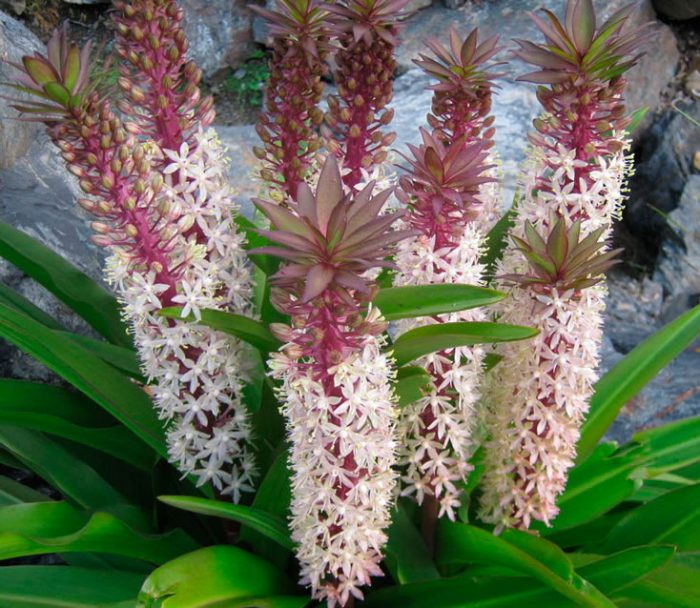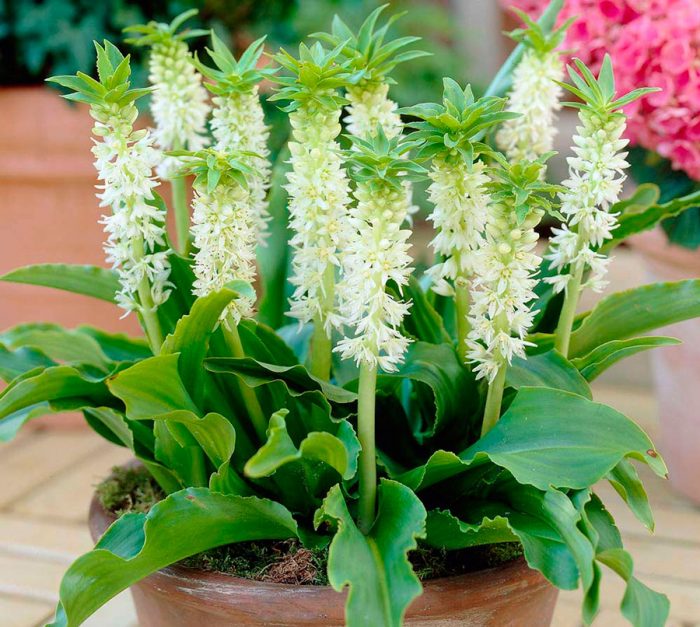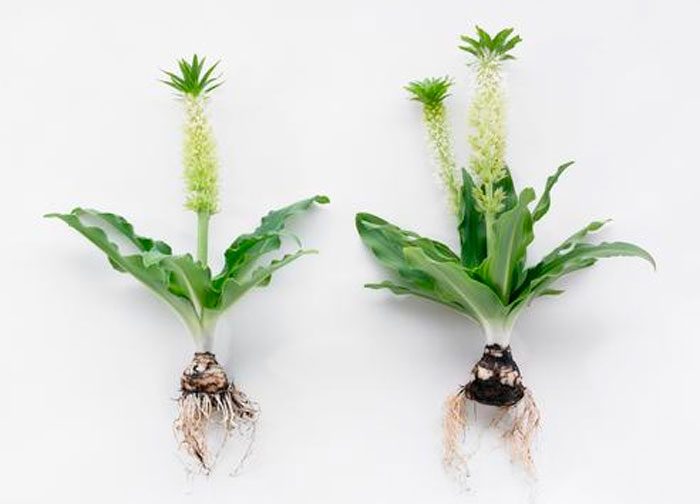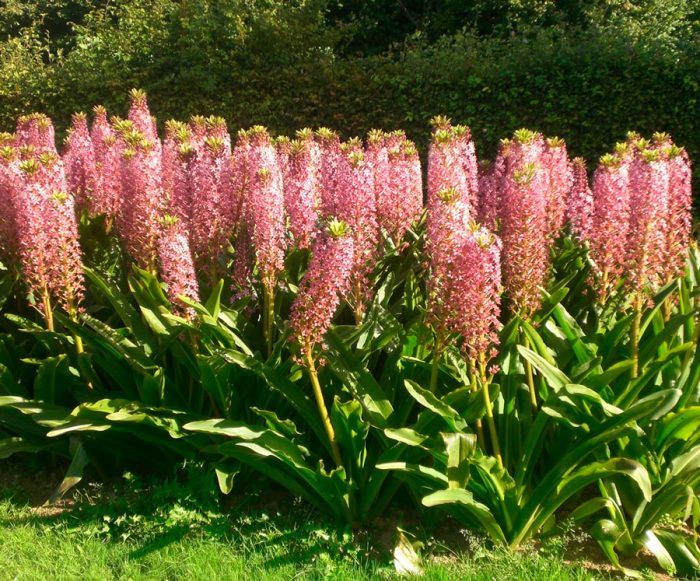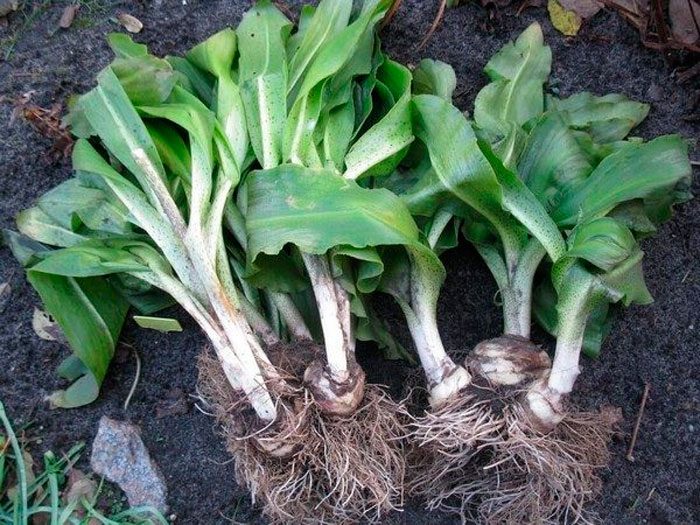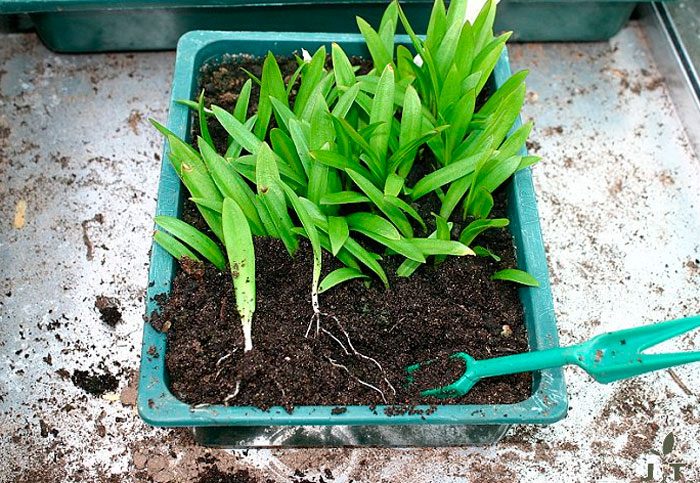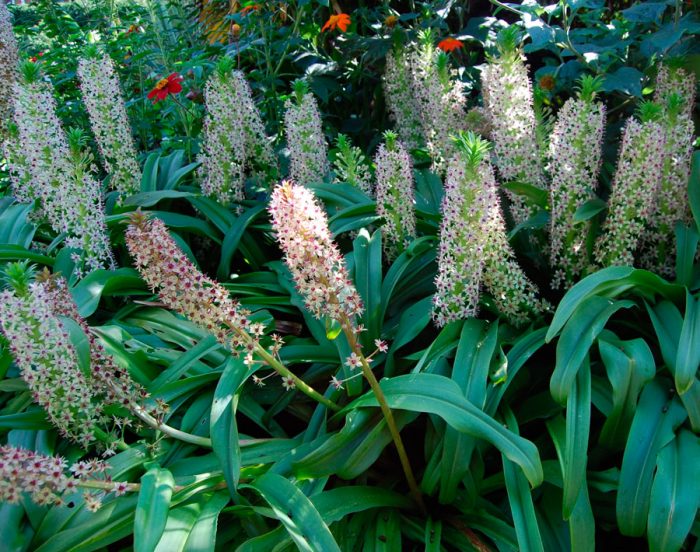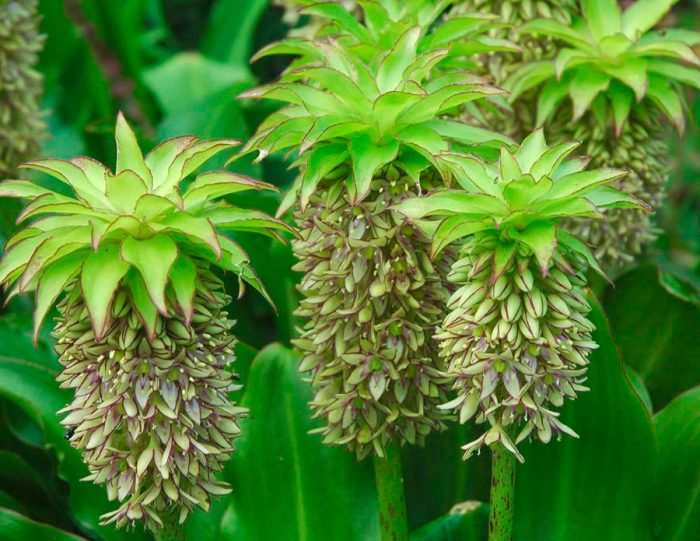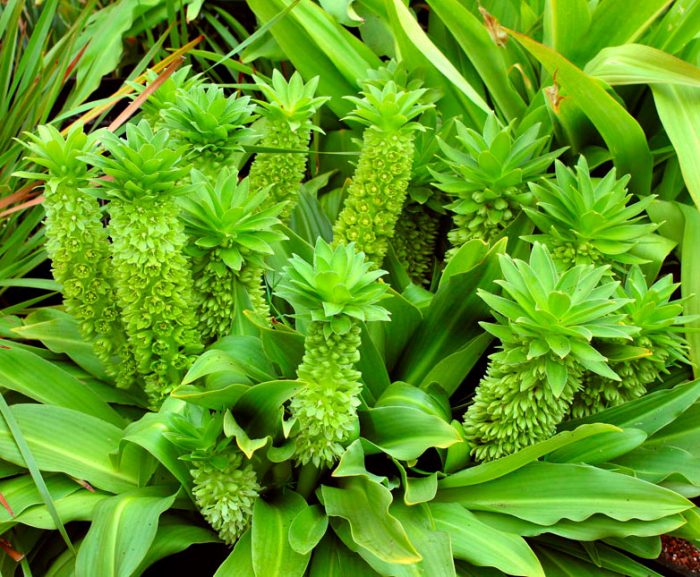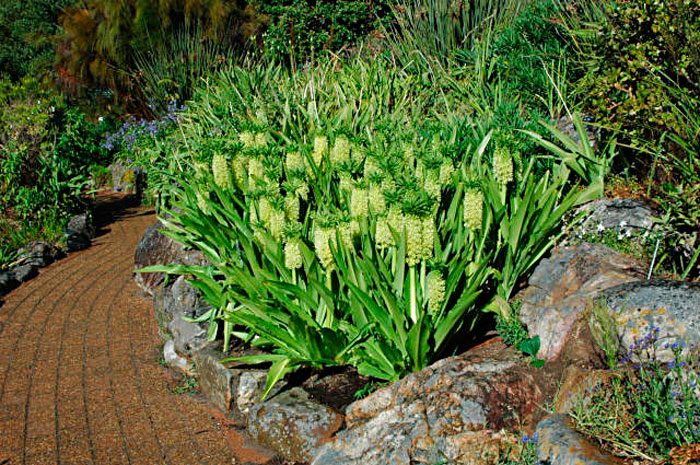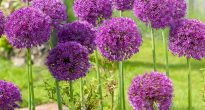The monocotyledonous flowering bulbous plant eukomis (Eucomis) is a member of the Asparagus family. In the wild, such a flower can be found in South Africa. "Eukomis" is translated from Greek as "handsome haired." So this genus was named by Charles Louis Leritie de Brutel, and this happened in 1788. 4 types of eukomis are cultivated by gardeners, and in total this genus unites 14 species. The advantage of this plant is that it retains its very high decorative effect even after the end of long flowering.
Content
Features of eukomis
Eukomis is a perennial herb. The bulbs, reaching 80 mm in diameter, are oval in shape. There are still many glossy basal leaf plates, their shape is belt-like or ovoid. The height of the cylindrical peduncles is about 100 centimeters. They grow racemose inflorescences, which are outwardly similar to pineapple, they reach about 0.3 m in length. The flowers are wheel-shaped, they are painted in light green or white with a purple or brownish tint. The flowers include 6 lobes of lanceolate perianths fused at the base, and 6 more fused stamens, which have swinging anthers. At the very top of the flower arrow above the flowers there is a bunch, which includes from 10 to 20 bracts of green color, it is thanks to them that this plant is similar to pineapple. The fruit is a three-ribbed box of a flat-rounded shape, inside there are ovoid or round seeds of a dark brown or black color.
Planting eukomis in open ground
What time to plant
Eukomis bulbs are planted in open soil in a well-warmed ground, after the return spring frosts are left behind, as a rule, this time falls on the last days of May or June. If your region has a relatively cold and long spring, then in this case it is recommended to begin with the bulbs to germinate in a deep container filled with soil mixture, and they are transplanted to the site in the last days of March or in the first - April.When planting a bulb for distillation, it should not be buried entirely in the soil mixture; the upper part should rise slightly above its surface.
Landing rules
Such a crop should be grown in a well-lit area that is protected from drafts and strong gusts of wind. The soil should be loose, light, well-drained and saturated with humus. To improve the moisture permeability of the soil, it should be dug up by adding gravel, river coarse sand, or broken brick.
During planting, the bulbs, depending on their size, must be buried in the ground by 25–35 mm, while the distance between the bushes should be at least 15 centimeters, and the width between the rows should be from 0.3 to 0.4 meters.
Caring for eukomis in the garden
How to water and feed
Regardless of where the eukomis bulb will be planted (in a pot for germination or in open soil), at first it should be watered very sparsely. But after the intensive growth of such a flower begins, it will need to be watered systematically and abundantly. After the plant is watered or it rains, it is imperative to loosen the surface of the soil near the bush, while pulling out all the weeds. When the plant has faded, watering should be gradually reduced. And after the leaf plates turn yellow, the bush must be stopped completely watering.
For a long and lush flowering, eukomis should be fed 2 times a month, using a mineral complex fertilizer in liquid form. But it should be borne in mind that the fertilizer should contain a minimum of nitrogen, such an eukomisu element is very harmful.
How to transplant
It is quite easy to grow such a flower in your garden. However, such a plant needs frequent replanting, which should be carried out every year, regardless of where it grows: in the open field or in a container. The fact is that such a culture is not highly frost-resistant. The bulbs will need to be removed from the ground in the autumn and this must be done before the frost begins. Then they are put into storage for the winter, after which they are again planted in the garden in the spring.
Reproduction of eukomis
This plant can be propagated by generative (seed) and vegetative propagation. If you propagate a bush in a vegetative way, then it retains all the varietal characteristics of the mother plant. During the season, a small number of children are formed on the parent bulb. The separation of children is performed when a period of rest is observed in eukomis. Places of cuts or faults should be sprinkled with crushed coal. Both separated and maternal bulbs are planted in open soil in the spring or the first weeks of the summer.
Only the species eukomis can be propagated by seed. Freshly harvested seeds are used for sowing. They are sown in boxes or pots filled with substrate. The first seedlings should appear after 4-6 weeks. Care for such plants should be exactly the same as for seedlings of any other culture. The first flowering of bushes grown from seeds can be seen only 3 or 4 years after sowing.
Reproduction of such a flower can be done by leaf cuttings. To do this, at the bush, it is necessary to tear off the leaf plate directly at its base, after which the leaf is divided into parts with a sharp object, the length of which should vary from 40 to 60 mm, while the lower or upper part should be marked. Then the segments are buried with their lower part in a soil mixture consisting of peat and sand to a depth of 25 mm. Then the leaf cuttings must be covered with a transparent cap on top and provided with a temperature of about 20 degrees. It is necessary to air the cuttings 1 time in 7 days, for this, removing the shelter for a while. After 2–2.5 months, small bulbs should form along the edges of parts of the leaf plates.They should be carefully torn off and planted in the substrate, where they should grow to the required size.
Wintering
After the bushes have faded, it is necessary to remove the flower arrows from them, while the leaf plates should remain, since thanks to them the eukomis will receive nutrients until autumn. In the first autumn weeks, yellowing, wilting and dying off of the leaf plates are observed, while the dormant period begins in the bulbs. When growing this crop in regions with relatively warm winters, where the air temperature does not fall below zero degrees, the bulbs, if desired, can not be removed from the ground, but simply before the cold sets in, the surface of the site is covered with a layer of spruce branches or flown leaves. However, in regions with frosty, little snow or unpredictable winter periods, it is recommended to remove the bulbs from the ground in the last days of September, remove soil residues from them and immerse them in Maxim's solution for a while. After they dry, they must be put in paper or cloth bags, which are stored in a cool and dry place with good ventilation. If there are few bulbs, then they can be stored for storage on the shelf of the refrigerator intended for vegetables, while taking into account that apples cannot be placed next to them. If desired, eukomis can be planted in pots filled with a suitable potting soil. They are stored at room temperature, while it is necessary, if necessary, to water the substrate a little so that it does not dry out.


Watch this video on YouTube
Diseases and pests
Most often, eukomis suffers from bulb rot. This happens due to stagnation of liquid in the soil during the growing season, and also improper storage during the dormant period contributes to this. Affected bushes or bulbs must be treated with a solution of a fungicidal preparation, for example: Topaz, Fundazol, Skor or another agent of similar action. To destroy the fungus, in most cases, you will need to process the bushes 2 or 3 times on the foliage, or pickle the bulbs in a solution of a product containing copper.
Most often, the plant suffers from mealybugs, aphids, spider mites and whiteflies. Aphids can harm such a crop when grown both outdoors and indoors. All other harmful insects settle only on the bushes grown at home. To exterminate pests, a solution of an insecticidal agent is used, while acaricides are used to kill ticks. Insectoacaricides like Aktara or Actellik will help get rid of any of the harmful insects listed above.
Types and varieties of eukomis with photos and names
Only a few types of eukomis are cultivated by gardeners.
Eukomis point, or eukomis crested (Eucomis punctata = Eucomis comosa)
This species came to Europe in 1778. The height of the bush varies from 0.3 to 0.6 m. Grooved flat leaf plates, linear or lanceolate, can reach 0.6 m in length and 7 centimeters in width. On the seamy surface there are specks of brown color. The composition of loose racemose inflorescences includes from 40 to 100 green flowers, which are located on three-centimeter long pedicels. The Strikata variety is of the greatest interest, it was created in 1790: the seamy surface of the leaf plates is lined with longitudinal stripes of red-brown color. There are also varieties that have purple or pink flowers.
Eukomis bicolor (Eucomis bicolor), or eukomis bicolor
A native of this species from South Africa, it appeared in Europe in 1878. Peduncles reach about 50 cm in length, their surface is streaked with strokes of purple color. In the last summer weeks, greenish flowers bloom, while their bracts are framed by a purple border. The fruits are dark red in color.Tubergen bred the Alba variety, whose flowers have a greenish-white color.
Eukomis autumn (Eucomis autumnalis), or eukomis otumnalis
This species differs from others in that it has a relatively high frost resistance, therefore in the southern regions it is left in the open ground for wintering. The height of the peduncles varies from 0.2 to 0.3 m. The racemose inflorescence consists of white-cream or white flowers. Blooms later than other species.
In addition to the varieties described, gardeners are much less likely to cultivate such as: Zambezian eukomis, Pole Evans, red-stemmed and wavy.
Eukomis in landscape design
Eukomis is a wonderful decoration for any garden plot. This flower is widely used as a solo plant, as it has strong peduncles, as well as clear structural forms. It can also be used for joint plantings, while groundcover annuals, gerberas, and also coniferous perennials are excellent partners for it. So, eukomis looks great together with heuchera, planted against the background of ground cover plants, for example, lobelia or alissum. In a rocky garden, such a flower also looks just amazing, its shiny leaf plates can emphasize the majesty of the stones. This flower crop can be planted almost anywhere and will look great everywhere.
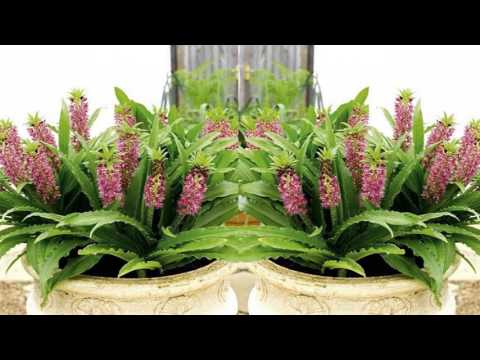

Watch this video on YouTube

